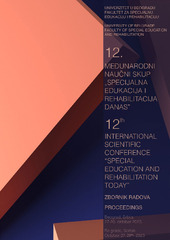Prikaz osnovnih podataka o dokumentu
Povezanost upotrebe asistivnih tehnologija i kvaliteta Života osoba sa motoričkim poremećajima: pregled Novijih istraživanja
The relationship of the assistive technologies use and the Quality of life of persons with motor disorders: A review of recent research
| dc.creator | Odović, Gordana | |
| dc.creator | Zrnić, Lana | |
| dc.date.accessioned | 2024-01-10T10:25:56Z | |
| dc.date.available | 2024-01-10T10:25:56Z | |
| dc.date.issued | 2023 | |
| dc.identifier.isbn | 978-86-6203-174-7 | |
| dc.identifier.uri | http://rfasper.fasper.bg.ac.rs/handle/123456789/5342 | |
| dc.description.abstract | Uvod: Osobe sa motoričkim poremećajima suočavaju se sa teškoćama u obavljanju aktivnosti svakodnevnog života, profesionalnih aktivnosti, aktivnosti slobodnog vremena i socijalnoj participaciji. Sve to značajno narušava kvalitet njihovog života. Uređaji asistivne tehnologije olakšavaju i omogućavaju funkcionisanje osoba sa motoričkim poremećajima s ciljem da se unapredi njihova samostalnost u obavljanju aktivnosti, socijalna participacija i kvalitet života. Cilj: Cilj ovog rada odnosio se na pregled dosadašnjih istraživanja o povezanosti upotrebe asistivne tehnologije i kvaliteta života osoba sa motoričkim poremećajima. Metode: Formulisana su sledeća istraživačka pitanja: koje su vrste asistivnih tehnologija primenjivane u studijama o kvalitetu života osoba sa motoričkim poremećajima, da li korišćenje uređaja asistivne tehnologije ima uticaj na poboljšanje kvalitet života i koje su dodatne koristi upotrebe asistivnih tehnologija za osobe sa motoričkim poremećajima. Identifikacija odgovarajućih radova izvršena je pretraživanjem elektronskih baza podataka PubMed, MEDLINE, ERIC i JSTOR, a odnosila se na period od 1. januara 2012. do 31. decembra 2022. godine. Definisani su kriterijumi za uključivanje i isključivanje radova za razmatranje. Rezultati: Identifikovano je ukupno 478 radova, a sve postavljene kriterijume ispunilo je 14 radova. Većina studija objavljena je u periodu od 2019. do 2020. godine, a ispitivana je povezanost pomagala za kretanje, robota, virtuelne realnosti, alternativnog input sredstva i sistema za kontrolu okruženja sa kvalitetom života osoba sa motoričkim poremećajima. Iako su studije imale izvesna metodološka ograničenja, postoje dokazi da asistivne tehnologije poboljšavaju kvalitet života bez obzira na vrstu motoričkog poremećaja, a posebno u domenima fizičkog i psihičkog zdravlja, kao i funkcionisanja u okruženju. Pojedine studije ukazale su na dodatnu korist upotrebe asistivnih tehnologija u rehabilitacione svrhe, kao i u poboljšanju u pokretljivosti, obavljanju aktivnosti, prilagodljivosti, samopouzdanju i samostalnosti. Zaključak: Dokazi iz odabranih studija ukazuju da asistivne tehnologije unapređuju kvalitet života, a prisutne su i dodatne koristi za osobe sa motoričkim poremećajima. U tom smislu ima više podataka o upotrebi pomagala za kretanje, a manje o novijim, sofisticiranim asistivnim tehnologijama, pa bi buduća istraživanja trebalo usmeriti u tom pravcu. | sr |
| dc.description.abstract | Introduction: Persons with motor disorders face difficulties performing activities of daily living, professional activities, leisure activities, and social participation. All of this significantly impairs their quality of life. Devices of assistive technologies facilitate and enable people with motor disorders to improve their independence in performing activities, social participation, and quality of life. Aim: This article aimed to review previous research on the connection between the use of assistive technologies and the quality of life of people with motor disorders. Methods: The following research questions were formulated: what types of assistive technologies were applied in studies on the quality of life of persons with motor disorders, whether the use of assistive technology devices has an impact on improving the quality of life, and what are the additional benefits of using assistive technologies for persons with motor disorders. The identification of relevant articles was performed by searching the electronic databases PubMed, MEDLINE, ERIC, and JSTOR, and related to the period from January 1, 2012, to December 31, 2022. Inclusion and exclusion criteria were defined. Results: A total of 478 papers were identified, and 14 articles met all the set criteria. Most of the studies were published from 2019 to 2020, and the connection of mobility aids, robots, virtual reality, alternative input devices, and environmental control systems with the quality of life of people with motor disorders was examined. Although the studies had certain methodological limitations, there is evidence that assistive technologies improve the quality of life regardless of the type of motor disorder, especially in the domains of physical and psychological health and functioning in the environment. Certain studies have indicated the additional benefit of using assistive technologies for rehabilitation purposes, as well as in improving mobility, the activities performance, adaptability, self-confidence, and independence. Conclusion: Evidence from selected studies indicates that assistive technologies improve the quality of life, and there are additional benefits for people with motor disorders. In this sense, there is more data on the mobility aids use, and less on new, sophisticated assistive technologies, so future research should be directed in that sense. | sr |
| dc.language.iso | sr | sr |
| dc.publisher | Univerzitet u Beogradu – Fakultet za specijalnu edukaciju i rehabilitaciju/ University of Belgrade – Faculty of Special Education and Rehabilitation | sr |
| dc.rights | openAccess | sr |
| dc.rights.uri | https://creativecommons.org/licenses/by-sa/4.0/ | |
| dc.source | Zbornik radova - 12. Međunarodni naučni skup Specijalna edukacija i rehabilitacija danas Beograd, 27–28. oktobar 2023. Godine | sr |
| dc.subject | asistivna sredstva | sr |
| dc.subject | invaliditet | sr |
| dc.subject | kvalitet života | sr |
| dc.subject | assistive devices | sr |
| dc.subject | disability | sr |
| dc.subject | quality of life | sr |
| dc.title | Povezanost upotrebe asistivnih tehnologija i kvaliteta Života osoba sa motoričkim poremećajima: pregled Novijih istraživanja | sr |
| dc.title | The relationship of the assistive technologies use and the Quality of life of persons with motor disorders: A review of recent research | sr |
| dc.type | conferenceObject | sr |
| dc.rights.license | BY-SA | sr |
| dc.citation.epage | 321 | |
| dc.citation.spage | 313 | |
| dc.identifier.fulltext | http://rfasper.fasper.bg.ac.rs/bitstream/id/10929/Untitled9.pdf | |
| dc.identifier.rcub | https://hdl.handle.net/21.15107/rcub_rfasper_5342 | |
| dc.type.version | publishedVersion | sr |


